#Buddhist deities
Explore tagged Tumblr posts
Text








Laughing Buddhas From The Flying Peak
Vivid figures of Buddhas and Bodhisattvas carved in the rock on the Flying Peak, Feilai Feng (飛來峰石窟) in the Wulin Mountains (武林山), Zhejiang.
Their cheerfulness in no way contradicts the solemn and misty ambiance of the Feilai Feng Grottoes themselves. Limestone peak looks alien in the surrounding mountain landscape, so there is an opinion that it flew here by the power of Buddhist wonder-workers. The main cave is dedicated to the Bodhisattva Guanyin. Due to a natural crack in the ceiling, a radiant halo surrounds the statue.
The carvings are from different periods and date from the Tang to the Ming.
Photo: ©俊灵-
#ancient china#chinese culture#chinese art#buddha#buddhist#buddhist deities#buddhism#buddhist temple#guanyin#chinese mythology#观音#religious art#rock carvings#buddha statue#bodhisattva#chinese folk religion#tang dynasty#song dynasty#yuan dynasty#ming dynasty
267 notes
·
View notes
Text
Buddhist Deities Exiled From the Western Heaven
My new article examines the reasons why three Buddhist deities from Ming-Qing vernacular Chinese literature are exiled from the Western Heaven.
Master Golden Cicada (Jinchan zi, 金蟬子) (a.k.a. Tripitaka, Tang Sanzang, 唐三藏) from Journey to the West (Xiyouji, 西遊記, 1592) - a Buddha disciple who is caught sleeping during the Tathagata's sermon.
Miao Jixiang (妙吉祥) from Journey to the South (Nanyouji, 南遊記, c. 1570s-1580s) - A Buddha disciple who kills a belligerent sage on the grounds of the Thunderclap Monastery.
Great Peng, the Golden-Winged King of Illumination (Dapeng jinchi mingwang, 大鵬金翅明王) from The Complete Vernacular Biography of Yue Fei (Shuo Yue quanzhuan, 說岳全傳, 1684) - An avian dharma protector who kills a stellar-spirit for farting during the Tathagata's lecture.
The article analyzes them together and notes parallels, even with concepts from Greek philosophy.
The motif might serve as a good idea for writers wanting to create an OC with an interesting backstory. I have, for example, previously used it to suggest a fictional origin for Sun Wukong as a hot-tempered Bodhisattva (see the 06-16-23 update here).
#Buddhist deities#Chinese fiction#Master Golden Cicada#Golden Cicada Elder#Journey to the West#JTTW#Miao Jixiang#Journey to the South#JTTS#Great Peng#Great Roc#Yue Fei#story idea#story motif
49 notes
·
View notes
Text

Mohini & Kurukulla
💕The enchantresses 💕
#hinduism#Buddhism#desiblr#hindu gods#Mohini#Kurukulla#hindu mythology#buddhist deities#hindu god#hindu myths#hindublr#tibetan buddhism#Buddhist#Blue-Lotus arts#desi tag#goddess#goddesses#bodhisattva#art#Vaishnavism#Hindu art#Buddhist art#my art
30 notes
·
View notes
Text

Buddha Vajrapani
Buddha transforming into Vajrapani
9 notes
·
View notes
Note
Dude does that mean he'd be friends with Sun Wukong as well?
Vasant getting inspired by Varuni so let's not kid ourselves. SHE'S INFLUENCING HIM
We got three colors atp LMAO
Buddhist Vasant is so cute. He's one of the Balabhadra deities, who are basically companions of Kama
And this is how he's described in the the Niṣpannayogāvalī (dharmadhātuvāgīśvara-maṇḍala):—
“Vasanta rides on a monkey and is white in colour. He is four-armed and in his two right hands he holds the arrow and the sword. With the two left he carries the bow and the wine-glass”.
OMGGG BUDDHIST VASANT HAS A MONKEY THAT'S SO CUTE
Also why's bro always with wine and shit wth- 💀
ALSO NEW VASANT COLOUR UNLOCKED
He's so cute omggshdvdvdvvd
#vasant#buddhist vasant#vasanta#buddhism mythology#buddhism#buddhist gods#buddhist deities#buddhism deities#desiblr
8 notes
·
View notes
Text
as a native chinese, i feel like some of yall are taking the gods in lego monkie kid a bit too seriously. i understand why it feels iffy to ship / make silly content of deities that people worship irl (eg. nezha, sun wukong) but it’s a phenomenon on chinese social media too. c-netizens ship the fictionalized versions of these gods, which the gods of lego monkie kid are. they aren’t the actual gods people worship; they’re slightly tweaked versions of the book characters, just like any other chinese adaptation or retelling of jttw (and such stories like fsyy) also, no, nezha isn’t a child, in lmk or jttw or sometimes irl. just because he’s often depicted in child form doesn’t make him an immortal child. eros / cupid is often depicted as a winged baby, and he has a wife and kids. it’s basically the same thing here. nothing in lmk suggests that nezha is a child (his voice, his appearance, his personality etc. all imply he is an adult), and while he’s described as youthful in jttw, he’s already 1700+ years old by then and gods can shapeshift. people only think he’s an immortal baby because that’s a popular depiction of him, since one of his prominent myths is set during his childhood. but as long as you’re talking about the god nezha (fictionalized or the religious figure) and not the human child nezha, then that’s an adult [edit: the last sentence couldve been worded better. i would summarize it as “immortal youth nezha is a valid depiction and is popularized by mythology, but adult god nezha exists too and they are NOT mutually exclusive”]
#i’m not even here for shipping discourse ie. “you can’t ship nezha w anyone cuz he’s a child!”#i dont ship him with anyone that’s never been my focus#i just dislike misinformation#if you understand that cupid and eros are adult gods despite often being depicted as babies then why don’t you understand this#and in case i need to clarify i hate pr*sh*pping i dont support it#the fact is that any lmk nezha ship simply isn’t a pr*sh*p because he’s a full grown man#never once in the show does he act or sound like a child so why is this such a widespread belief??#i’d get it if the show was about him as a child going on his killing spree#but lmk is clearly set millennia after that#also abt the “dont ship deities” thing i understand seeing non-cn fans treat chinese gods like fairytale characters is frustrating#but to me since lmk characters aren’t very accurate to their real life religious counterparts they are not the same ppl#like i see swk fanart and think “swk the lmk character” and not “swk the daoist god” yknow#but that’s only my opinion i wont say i’m totally right i won’t argue if you’re daoist or buddhist and find it offensive#lego monkie kid#lmk#jttw#journey to the west#lmk nezha#lmk swk#lmk sun wukong#age discourse#immortal child depictions of nezha do exist that doesn’t mean the god is always a child#and in FICTION. yknow SHOWS and STORIES. not worship. if the story says he’s an adult then that’s what he is#so like. statue of baby nezha = baby#statue of adult nezha = adult. it does not mean every single depiction of nezha is a child#don’t generalize things and do not infantalize him
90 notes
·
View notes
Text

[21.07.23]
It’s been a year since the release of the Venture Bros movie “Radiant is the blood of the baboon heart” , so what better way to celebrate than draw none other than Mantilla herself. For those unfamiliar , mantilla is a character introduced in that movie, serving as the main antagonist and also something that ties the answer to the 7 season long question about the titular venture brothers : who is their biological mom?
Feeling proud of this one because I managed to shoehorn Thai (and buddhist) mythology into it, the pose she’s making is based off the earth deity , พระแม่ธรณี / Dharani’s. The figures to the top left is the release da the of the movie in Thai numerals.
#the venture bros fanart#the venture bros#the venture bros movie#radiant is the blood of the baboon heart#mantilla#Debra st. Simone#crarb vbros#crarb illus#she’s so mother of course I had to draw her in the pose of the Buddhist deity mother dharani
92 notes
·
View notes
Text

“Dog, talk not to me neither of knees nor parents; would that I could be as sure of being able to cut your flesh into pieces and eat it raw, for the ill you have done me, as I am that nothing shall save you from the dogs—it shall not be. Your mother shall never lay you out and make lament over the son she bore, but dogs and vultures shall eat you utterly up.”
#achilles#the iliad#tagamemnon#greek mythology#blood tw#turns out the thing to get me out of my drawing funk is some fucked up snarling men! there are many more snarling men in my sketchbook#ft a variation on achilles's design where he takes after his mother (whom i imagine with greyish skin and oceanlike blue black hair)#the main inspiration was that dog beast from otgw but i also feel like theres traces of... fierce buddhist deities??#like those depictions of mahakala where he has his mouth open and eyes bulging and fang everywhere. my absolute favourite#anyway im mildly annoyed that i couldnt find the exact quote that sparked this idea partly because i listened to the e. wilson translation#but im looking at the gutenberg version
23 notes
·
View notes
Text

Grahamatrika
#Grahamatrika#Grahamātṛkā#vajra#mandala#buddhism#tibetan buddhism#buddhist deity#dharani#mantra#matri#matrika#matar#Vidyarajni#Mahavidya#female deity
19 notes
·
View notes
Text

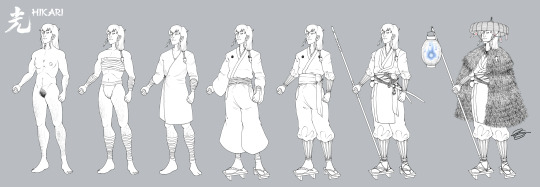
Woe! Transgender samurai be upon ye!
-pulling my old OC out of the filing cabinet and giving him a shampoo- LOOK I HAVE A NEW CHILD!! :D
I've decided to rework an old story/universe from several years ago, so here we go again, from the top:
---------------------------------------------------------------------------
暁の物語 Akatsuki no Monogatari
光 Hikari
Hikari, aka Shitaikou, is a young ronin, a master-less samurai, wandering around Edo-era Japan on a soul-searching journey.
He was raised as a girl named Sayoko (小夜子) by a samurai family, and taught swordsmanship and the arts like his brothers, although he was never destined to become a warrior. When the time came to find him a husband, he stole two swords, ran away and changed his name.
He now walks the roads of Japan on a quest to find [insert as-of-yet undefined quest here], and offers his assistance to villagers on the way. In doing so, he often runs into yokais and other paranormal occurences, to the point where in time he becomes an expert on the occult underworld of Japan and is often nicknamed the Demon Samurai.
Hikari is accompanied in his travels by Chihiro (千尋), a kitsune, and by Mochi (餅), a totally normal cat with the usual amount of tails and absolutely no supernatural powers, no siree. He is also regularly involved with an onnagata (a cross-dressing kabuki actor) and a yokai-hunting Buddhist monk, both of which I have yet to name (Mochi's name is also susceptible of being changed soon), and meets all kinds of strange people on his travels.
Hikari has a kind heart and a strong sense of honour. His driving force is his desire to help others; although he is very naive at first, and misguided altruism often gets him in trouble. As the story progresses, he will grow more mature and cynical, often preferring the company of yokais to that of humans, but trying to retain hope and faith in his fellow men.
(You can see older drawings of Hikari, including different outfits, here)
---------------------------------------------------------------------------
Akatsuki no Monogatari (the Tale of Dawn) takes place in the very beginning of the Edo era, in the transition years between the warring period of the Sengoku-Jidai and the two hundred years of peace under the Tokugawa shogunate. It is a story about change and beginnings, both of a person and of a country.
Some name lore under the cut!
The kanji Hikari 光 means "light". Hikari is a "public first name", sort of an official nickname. It was common practice in feudal Japan (at least among the samurai class) to go by a public name and keep your real name private. In Hikari's case, that is also because he often frequents yokais and magicians, who could use his true name against him.
His real name is Shitaikou 志泰光 . The kanjis composing it mean "aspire", "gentle" and "light". He chose it as a reminder to himself to strive for kindness and to make the world a better place.
("Hikari" is the last kanji composing this name. When used with other kanjis, it is pronouced "kou". Such is the messed-up way kanjis work. -frustrated weeb noises-)
Hikari doesn't have a last name; he gave up his family's name when he ran away and saw no use in taking a new one: as a ronin he is not tied to any family.
His birth name, Sayoko 小夜子 , is composed of the kanjis "small", "night" and "daughter". Hence the title, Akatsuki no Monogatari, the tale of dawn, or how the night turns into the light.
#formerly this universe was called hakatsuki no monogatari because i had somehow convinced myself that akatsuki starts with an h (??????????)#the as-of-yet undefined quest may be a quest for a gender-transing yokai or deity#i need to do more research into shinto and buddhist deities i'm sure there must be one that fit the bill#or i can just use inari. their gender is unclear and their messenger animal is a fox which is well-known for shapeshifting#anyway i need to draw the rest of the cast and find a name for the onnagata#spoiler she's hikari's gf and they're T4T <3#my ocs#hikari#akatsuki no monogatari#samurai#ronin#japan#edo#transgender#blorbo from my brain
25 notes
·
View notes
Text
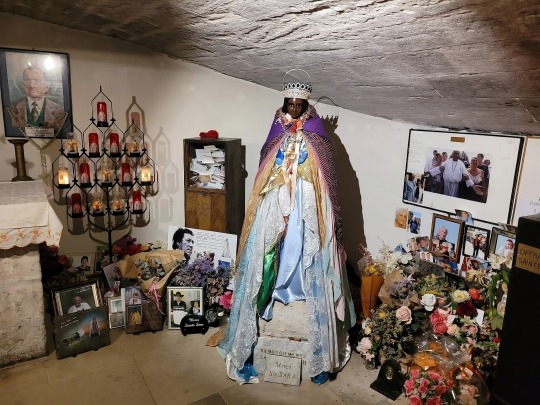

the shrine of saint sarah in the church of the saintes-maries-de-la-mer in in the camargue in france. the church itself was built in the 9th century and named for and dedicated to the three marys. a popular french legend goes that they and their maid, sarah, landed on a camargue coast.
saint sarah, or sarah-e-kali (sarah the black, “the black” is a title sometimes given to black/dark-skinned saints) in romani, is the patron saint of roma people in latin catholicism, though she isn't recognized by the catholic church. she is also revered as a protector for marginalized and poor people in general. her origins are thought to lie in a syncretization of the hindu goddess kali, the story of sarah along with the three marys, and the tradition of black madonnas. (christian roma have historically venerated other black madonnas as well.) the church is her major shrine - she's venerated here annually on the 24th of may by roma pilgrims.
#france#romani#interior#worship#christian#my posts#brahmic (hindu buddhist etc) deities are syncretized into a bunch of very specific forms depending on where you look#and one can have a bunch of different forms that are ultimately the same being/idea#it fits perfectly into the concept of saints if you think about it#not that people think saints are gods but the like. manifestations thing#i think there's some syncretic christianity/west african religions/hindu traditions in places 18th/19th century enslaved indians#were shipped to (mostly in central/south america which has a big history of syncretic christianity in general)
22 notes
·
View notes
Text

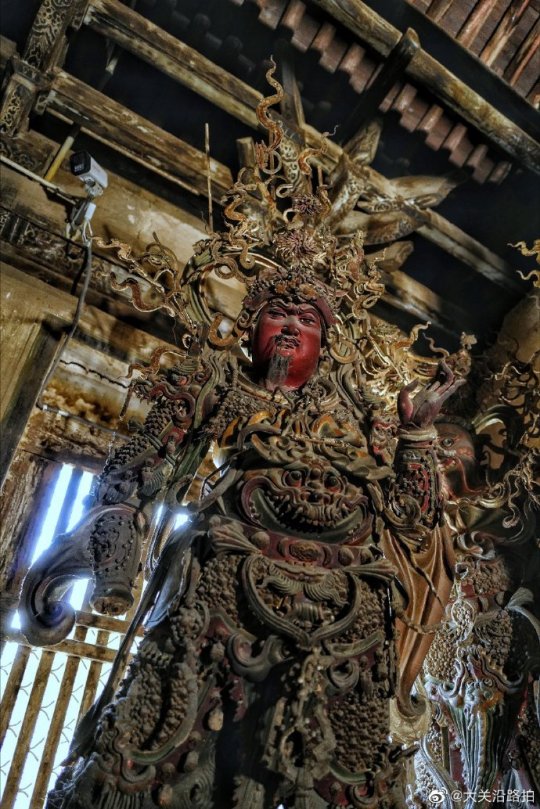
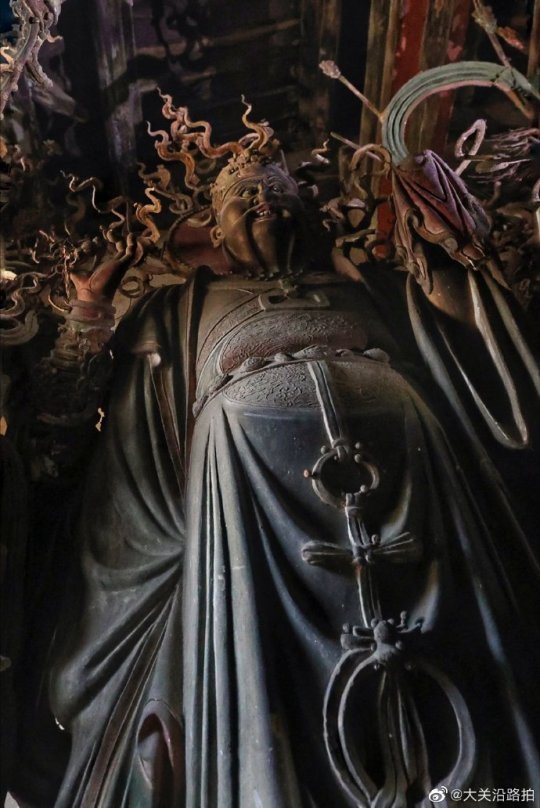
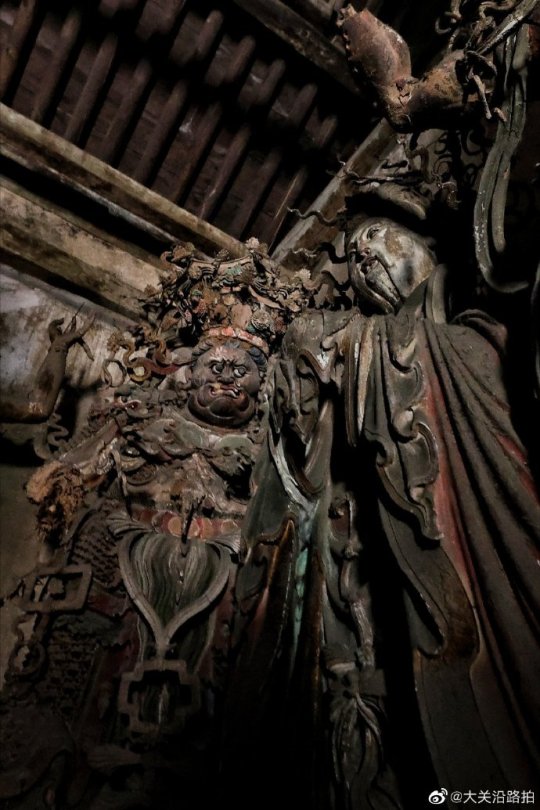
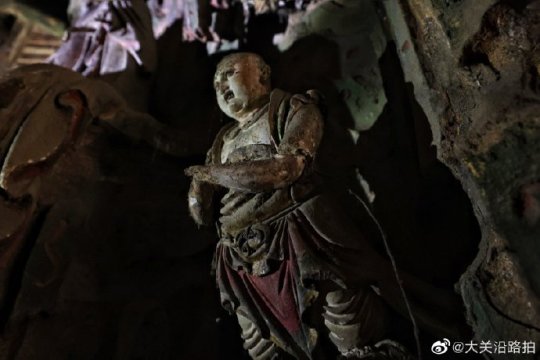


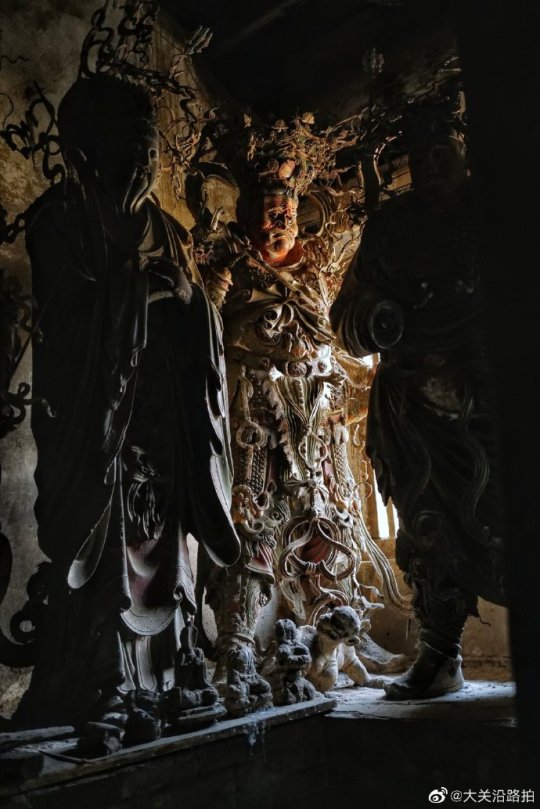
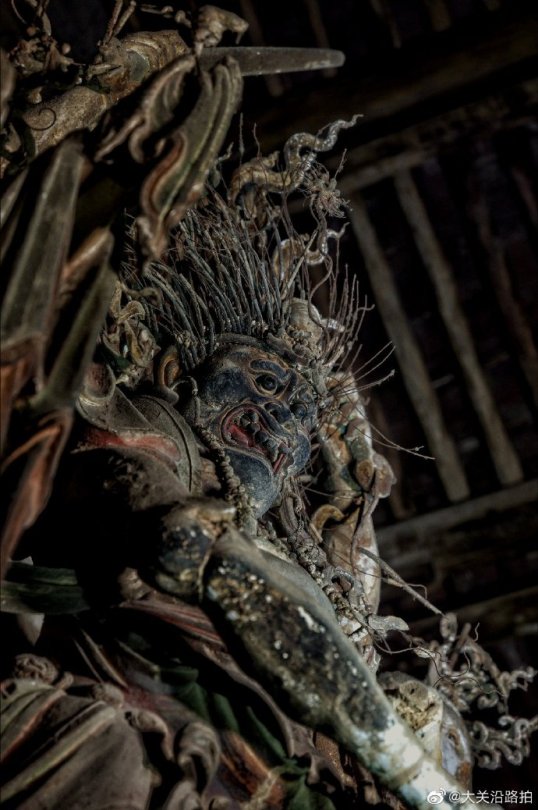
Extreme Baroque: Iron Temple On The Rice Mountain
Grotesque images from the Buddhist Iron Temple (鐵佛寺).
Located on the Rice Mountain (米山), Mixi (米西村) village, Jincheng, Shanxi, the temple is of an unknown construction date. The earliest record on the stone pillar in the main hall dates back to the seventh year of the Dading (大定) period of the Yuan or Jin dynasties. There is evidence that the temple was reconstructed in the third year of Wanli (1575). However, in the county annals, it is mentioned no earlier than the Qing dynasty.
These astonishing, presumably Ming statues owe their creation to the proximity of an iron ore. Iron frames made it possible to give the clay figures intricate poses and frilly decor.
Photo: ©大关沿路拍
#ancient china#chinese culture#chinese mythology#chinese art#chinese architecture#yuan dynasty#jin dynasty#chinese temple#statues#sculptures#scultpure#buddhist temple#buddhist#buddhist deities#religious art#buddhism#ming dynasty#qing dynasty#statuary#religious imagery
209 notes
·
View notes
Text

Six Arm Mahakala (Dharma Protector).
Their function is to protect the Buddha's teachings from being diluted or distorted.
#buddha#buddhist#buddhism#dharma#sangha#mahayana#zen#milarepa#tibetan buddhism#thich nhat hanh#mahakala#enlightenment spiritualawakening reincarnation tibetan siddhi yoga naga buddha#deities
10 notes
·
View notes
Text
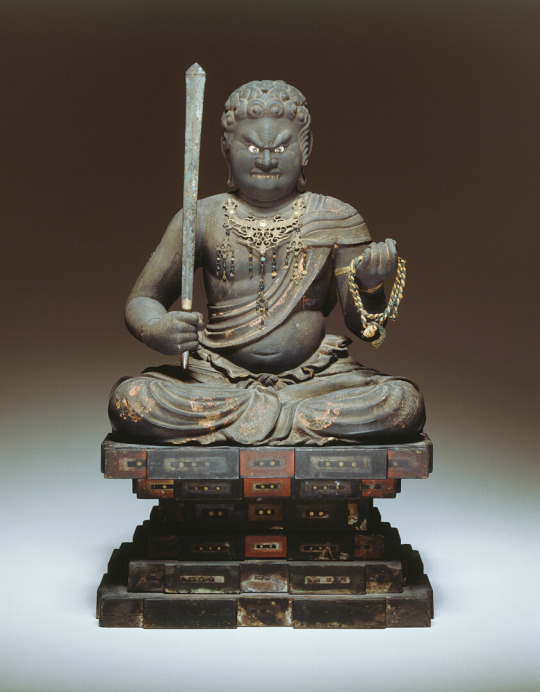
"HE IS EQUIPPED TO GUIDE THE SPIRITUAL TRAVELER PAST TEMPTATION ON THE PATH TO ENLIGHTENMENT."
PIC INFO: Resolution at 843×1080 -- Fudō Myōō, a Buddhist deity and guardian of the Buddhist law. His name translates to "The Undefeatable Enlightened King of Buddhism," or "the immovable or unshakable one."
DATE: 13th century (1199-1399)
ARTIST: Japan
DEPARTMENT: Arts of Asia
TITLE: Fudo Myo-o
ORIGIN: Japan (Artist's nationality)
MEDIUM: Wood with polychromy and gilt-bronze accessories
CREDIT LINE: Gift of the Joseph and Helen Regenstein Foundation
OVERVIEW: "The name Fudo Myo-o means “the immovable or unshakable one.” He is one of five myo-o, or lords of light, whose threatening appearance guards the Law of Buddhism. He is equipped to guide the spiritual traveler past temptation on the path to enlightenment. Fudo’s bulging eyes, piercing stare, and protruding fangs express the intensity of his wrath against evil. Seated on a stylized rock formation that symbolizes his steadfastness, he once held his attributes, a rope and sword (these have been removed for conservation), which were used to subdue evil forces and to cut through the ignorance that is the source of suffering. This finely modeled figure reflects the highly detailed, realistic direction taken by Japanese sculptors in the Kamakura period (1185–1333)."
-- THE ART INSTITUTE OF CHICAGO
Source: www.artic.edu/artworks/8085/fudo-myo-o.
#The Art Institute of Chicago#Lords of Light#Buddhist deity#Guardian of the Buddhist law#The Undefeatable Enlightened King of Buddhism#Japanese Buddhism#Art Institute of Chicago#Statue of Fudō Myōō#Acala#Early 13th century#Kamakura period#The Immovable#Acalanātha#Immovable Lord#Noble Immovable Lord#Wrathful deity#Protector of the Dharma#East Asian Buddhism#Japanese Culture#Japan#Japanese#Buddhist#Fudō Myōō Statue#Japanese Esoteric Buddhism#Dharmapala#Buddhism#Fudō Myōō#The Unshakable One#The Immovable or Unshakable One#Fudo Myo-o
5 notes
·
View notes
Text
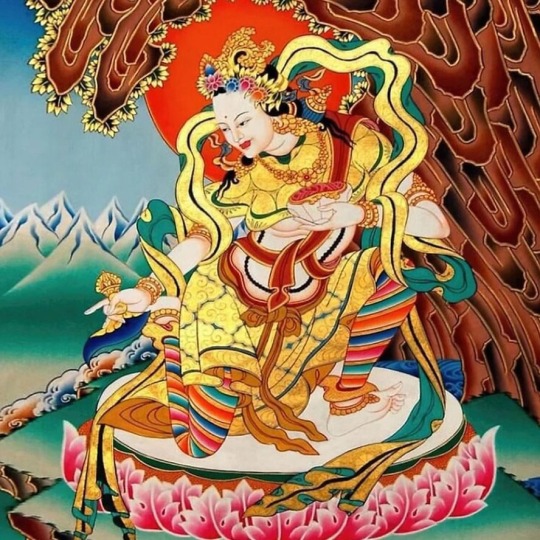
Tomorrow is Dakini Day and the anniversary of the birth of Yeshe Tsogyal. We hope that you are able to honor this special day tomorrow.
Yeshe Tsogyal is known as the “Queen of the Dakinis” and is considered the Mother of Tibetan Buddhism. She was a principal disciple and consort of Guru Rinpoche. The Dakini in Tibetan Buddhism represents the dynamic play of energy, and is also known as the “sky dancer.”
“When Emptiness and Awareness are set free, you are nothing if not a Buddha ... there is nothing but the spontaneity of pure potential. There is no other way to dance in the sky.”
~ Yeshe Tsogyal, from the book “Sky Dancer: The Secret Life and Songs of Lady Yeshe Tsogyal”
[Red Pine (translator) :: Bill Porter (author)]
+
May you be at peace. May your heart remain open. May you awaken to the light of your own true nature. May you be healed. May you be a source of healing for all beings.
Tibetan Buddhist Prayer
#dakini#dakini day#skydance#motherearth#goddess#deity#meditation#embodiment#the Divine#Red Pine#Bill Porter#Buddhist Prayer
43 notes
·
View notes
Text
Wrathful Deity Vibes
I really like hearing how Kaneko designed the Chaos Hero in Shin Megami Tensei with Dragon Ball Z in mind. Apparently he said in Kaneko Works I that he made Chaos Hero's demon fusion design was had both Piccolo's clothes and Goku's hair and overall vibe.

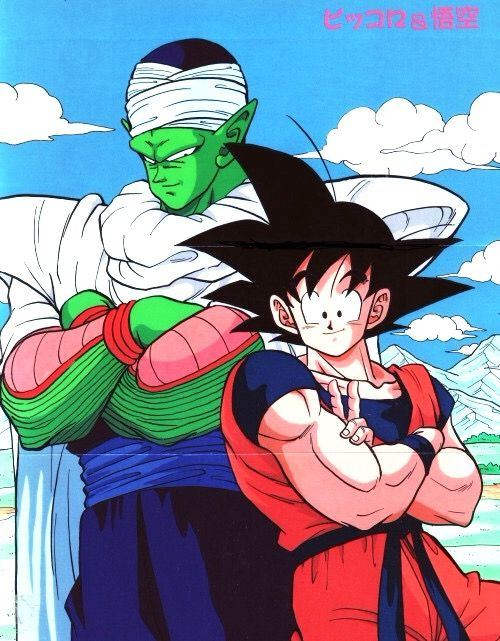
Kaneko also said that the hair was based on the Super Saiyan concept in general, which I find very interesting.
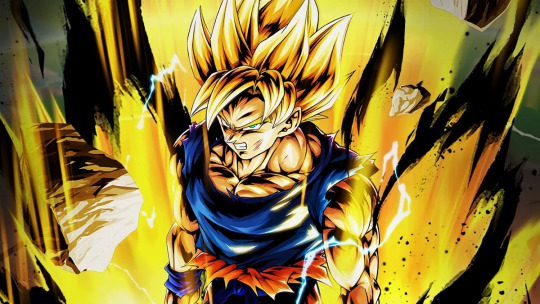
I remember an article that Richmond Lee wrote about Asura's Wrath on Art Eater way back. I can't find it anywhere for some reason, or if I have the link doesn't work anymore, but I really liked reading about the numerous connections between Buddhist art and Japanese popular culture, especially the wrathful deities.
Here's a screencap I could still find from the article below:

Asuras don't always have spiky hair, but there are definitely instances of Asuras with spiky hair in Japanese Buddhist iconography.

Not to mention modern tattoo art.

But I think the image on the left of that screencap is not an Asura, but rather Daigensui Myoo (a.k.a. Atavaka Vidyaraja), a fearsome Buddhist protector deity who was originally a yaksha.

Similar beings are of course frequently found in Buddhist art, where they are emphasized as wrathful and quasi-demonic protectors of the Buddhist teaching and enlightenment. Here's another screen from Richmond Lee's article which I think illustrates the connection to the Super Saiyan image (the image on the left here is a form of the wrathful deity Mahakala):

I always liked this connection, as I have loved the wrathful deity imagery in East Asian Buddhist art ever since I was exposed to the original Shin Megami Tensei. Of course, deities and demons of all alignments in the original game have what we might call Super Saiyan hair, but something about it makes sense in this aesthetic connection for both the Chaos Hero and some of the Chaos-aligned demon gods.


#shin megami tensei#dragon ball z#kazuma kaneko#buddhist art#demons#wrathful deities#hail chaos#anime#akira toriyama#super saiyan
11 notes
·
View notes